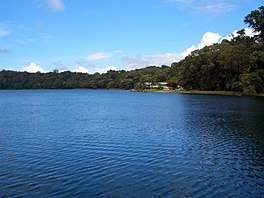Lake Barrine
| Lake Barrine | |
|---|---|
 taken from the lake's cruise | |
| Location | Far North Queensland |
| Coordinates | 17°15′01″S 145°38′07″E / 17.25028°S 145.63528°E |
| Type | Crater lake |
| Primary inflows | precipitation |
| Basin countries | Australia |
| Max. width | 1,230 m |
| Average depth | 65 m |
| Shore length1 | 4.5 km |
| Surface elevation | 730 m |
| 1 Shore length is not a well-defined measure. | |
Lake Barrine is a freshwater lake situated on the eastern parts of Atherton Tableland in Far North Queensland, Australia, close to Lake Eacham. The lake and surrounds are protected within the Crater Lakes National Park and are accessible via the Gillies Highway.[1]
Origin
Lake Barrine was formed over 17,000 years ago when a large volcano erupted, leaving a crater that over time filled up with water to create a lake. The crater or maar was formed as a result of a series of volcanic explosions. These explosions were caused by the hot molten rock coming into contact with groundwater. This caused a build-up of steam, gases and pressure which blasted the central core from the volcano. This massive explosion left a huge crater, which filled with rainwater to create Lake Barrine. Local Aboriginals called the lake Barany.[1]
Description

The largest of the natural volcanic lakes in the area, Lake Barrine is 730 m above sea level. It is about 1 km in diameter, with a shoreline of almost 4.5 km and an average depth of 65 m. No streams or springs feed the crystal clear lake; it is filled only by rainwater. During the wet season a small creek flows out of the lake. It joins Toohey Creek which is a tributary of the Mulgrave River.[1]
Facilities
There are walking tracks around the lake and tour operators offer cruises on the lake.[2] Facilities at the lake include picnic grounds, a kiosk and a pre-war tea house which was built in 1926.[1] Visitors may also swim in the lake and partake in birdwatching. Camping and domestic animals are prohibited near the lake.
Fauna and flora

The surrounding rainforest contains giant kauri (Agathis microstachya), red cedar (Toona ciliata) and flowering umbrella trees (Schefflera actinophylla). Wildlife common in the area include eastern water dragons, giant eels, saw-shelled turtles, scrub pythons (Morelia kinghorni), pied cormorants, black ducks, plumed whistling ducks, black coot, whistling kites, brahminy kites, black kites, white-breasted sea eagles and dusky moorhens.
World War II
During World War II the teahouse was used by the Australian Army as a convalescent home.[3]
See also
References
- ^ a b c d Shilton, Peter (2005). Natural areas of Queensland. Mount Gravatt, Queensland: Goldpress. pp. 48–51. ISBN 0-9758275-0-2.
{{cite book}}:|access-date=requires|url=(help) - ^ About Lake Barrine. Department of National Parks, Recreation, Sport and Racing. Retrieved on 29 December 2012.
- ^ Official website Accessed 2013-09-22
